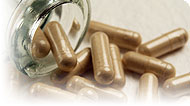Penn Herb Wellness Guide
Vitamin EFind Products

Vitamin E is an antioxidant that protects cell membranes and other fat-soluble parts of the body, such as low-density lipoprotein (LDL; “bad” cholesterol) cholesterol, from damage.
- Reliable and relatively consistent scientific data showing a substantial health benefit.
- Contradictory, insufficient, or preliminary studies suggesting a health benefit or minimal health benefit.
- For an herb, supported by traditional use but minimal or no scientific evidence. For a supplement,little scientific support.
Our proprietary “Star-Rating” system was developed to help you easily understand the amount of scientific support behind each supplement in relation to a specific health condition. While there is no way to predict whether a vitamin, mineral, or herb will successfully treat or prevent associated health conditions, our unique ratings tell you how well these supplements are understood by the medical community, and whether studies have found them to be effective for other people.
For over a decade, our team has combed through thousands of research articles published in reputable journals. To help you make educated decisions, and to better understand controversial or confusing supplements, our medical experts have digested the science into these three easy-to-follow ratings. We hope this provides you with a helpful resource to make informed decisions towards your health and well-being.
This supplement has been used in connection with the following health conditions:
| Used for | Amount | Why |
|---|---|---|
Anemia | 60 to 75 IU per day | Supplementing with vitamin E may improve anemia in cases of vitamin E deficiency. |
Anemia | 800 IU daily | as Vitamin E Oral Studies have reported that large amounts of vitamin E improve hemolytic anemia caused by a genetic deficiency of the enzyme glucose-6-phosphate dehydrogenase (G6PD). |
Epilepsy in Children | 400 IU daily | Supplementing with vitamin E can help improve treatment results in children. |
Immune Function | 200 IU daily | Vitamin E enhances some measures of immune-cell activity in the elderly. |
Intermittent Claudication | 400 to 600 IU daily | Taking vitamin E may improve blood flow and increase walking capacity. |
Rheumatoid Arthritis | 1,200 to 1,800 IU daily | Vitamin E is an important antioxidant, protecting joints against oxidative damage. Supplementing with vitamin E can help ease symptoms, including pain. |
Sunburn (Vitamin C) | 2,000 to 3,000 mg vitamin C and 1,000 to 2,000 IU vitamin E | Antioxidants may protect the skin from sunburn due to free radicalproducing ultraviolet rays. Combinations of vitamin E and C offer protection against ultraviolet rays. |
Tardive Dyskinesia | 1,600 IU daily | Vitamin E has been shown to reduce the severity of tardive dyskinesia. |
Alzheimer’s Disease | 2,000 IU daily | Antioxidant supplements such as vitamin E have been associated with lower risk of Alzheimer’s disease and improved brain function in middle-aged and older adults.
|
Anemia and Kidney Dialysis | 800 IU daily | as Vitamin E Oral Studies have reported that large amounts of vitamin E improve anemia caused by kidney dialysis. |
Angina | 50 IU daily | Low levels of antioxidant vitamins in the blood, particularly vitamin E, are associated with greater rates of angina. In one study supplementing with small amounts of vitamin E had a minor benefit in people with angina. |
Cold Sores | Apply cotton saturated with oil for 15 minutes every three hours on day one, then three times daily on days two and three | Applying vitamin E oil directly to a cold sore appears to accelerate healing. |
Dermatitis Herpetiformis | 10 IU daily | Supplementing with selenium and vitamin E has been shown to correct an antioxidant deficiency common in DH. |
Down Syndrome | 100 to 400 IU daily | Taking vitamin E may improve antioxidant protection. Ask your doctor before supplementing with this vitamin. |
Dysmenorrhea | 400 to 600 IU of vitamin E a day for five days, beginning two days before menstruation | Taking vitamin E beginning two days before menstruation may help prevent severe pain. |
Endometriosis (Vitamin C) | 1,000 mg vitamin C and 1,200 IU vitamin E daily | A combination of vitamin C and vitamin E can help lessen the pain of endometriosis. |
Gingivitis | Refer to label instructions | In one study, patients with periodontal disease who received vitamin E had improvements in various measures of gingival and periodontal health, compared to the control group. |
Hay Fever | 800 IU daily | In a study of people with hay fever, adding vitamin E to regular anti-allergy treatment during the pollen season significantly reduced the severity of hay fever symptoms. |
Heart Attack | 400 to 800 IU daily | Supplementing with vitamin E, synthetic or natural, may help reduce heart attack risk. |
High Cholesterol | Refer to label instructions | It is unclear whether supplementing with vitamin E can improve cholesterol levels. |
Hypertension | 200 IU daily | Supplementing with a modest dose of vitamin E may have a small positive impact on blood pressure in those with mild hypertension, but the evidence is not conclusive. |
Intermittent Claudication (Alpha-Linolenic Acid, Fish Oil, Folic Acid, Oleic Acid, Vitamin B6) | 200 mg of EPA and 130 mg of DHA daily, plus small amounts of vitamin B6, folic acid, vitamin E, oleic acid, and alpha-linolenic acid | In one study, men with intermittent claudication who drank a milk product fortified with fish oil, vitamin B6, folic acid, vitamin E, oleic acid, and alpha-linolenic acid could walk further without pain than those who drank regular milk. |
Leukoplakia | 800 IU daily | According to a review of clinical trials, the combination of beta-carotene and vitamin E has led to complete or partial remissions in six of eight trials studying people with leukoplakia. |
Lung Cancer | 200 to 400 IU daily | High vitamin E levels have been associated with a reduced lung cancer risk. In one trial, nonsmokers who took vitamin E had a 45% lower lung cancer risk compared with those who did not take the vitamin. |
Menopause | Refer to label instructions | Vitamin E may help reduce menopause symptoms. Many doctors suggest that women going through menopause try vitamin E for at least three months to see if symptoms improve. |
Neuropathy | 300 to 600 mg (450 to 900 IU) daily | Vitamin E supplementation may protect against diabetes- and chemotherapy-related neuropathy. |


